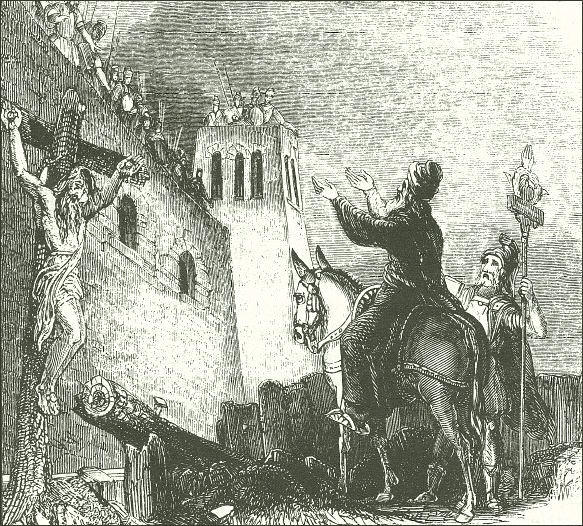
In my previous post I said I was wanting to explore in depth some of Lena Einhorn’s observations. One that I consider most striking concerns the climactic crucifixion itself. We are so used to hearing that crucifixion was a very common method of execution for rebels in Roman times that we don’t pause to ask questions when we read about Pilate’s crucifixion of Jesus along with two “thieves” or “robbers” (translated “bandits” in the NRSV):
Mark 15:27 — And with him they crucified two bandits [λῃστάς – lestes], one on his right and one on his left.
Matthew 27:38 — Then two bandits [λῃσταί – lestai] were crucified with him, one on his right and one on his left.
In the Gospel of John we find Barabbas, the one freed in exchange for Jesus, described the same way:
John 18:40 — They shouted in reply, “Not this man, but Barabbas!” Now Barabbas was a bandit [λῃστής – lestes].
Now λῃστής (lestes) is the Greek word for “robber”, but the historian who has left us an account of the Jewish War with Rome and the many decades prior to that event, Josephus, uses λῃσταί (the plural of λῃστής) to describe anti-Roman Jewish rebels. Josephus was writing around the same period that many scholars believe the evangelists were composing the our canonical gospels.
The gospel use of “lestai/rebels” to describe Barabbas and the two who were crucified with Jesus is not new. It is found in the scholarly literature readily enough.
Einhorn takes the next step and examines the times Josephus tells us the lestai were active. I have summed up Einhorn’s observations in the following table.
|
Accounts of “lestai” activity by Josephus |
||
| 63-37 BCE | 15 times | Beginning of Roman occupation |
| 37-4 BCE | 22 times | |
| 4 BCE – 6 CE | 6 times | Crushing of Census revolt |
| 6-44 CE | No references of lestai activity | Time of Jesus |
| 44-48 CE | 2 times | Return of direct Roman rule after death of Agrippa I |
| 48-59 CE | 20 times | |
| 59-66 CE | 21 times | Lead up to the war with Rome, 66-70/73 CE |
There is an exception that Einhorn points out:
The only hint about activity during Jesus’s time is a sentence in War, saying that “Eleazar the arch-robber,” active in the 50s, together with his associates “had ravaged the country for twenty years together.” In Antiquities, however, it only says that Eleazar “had many years made his abode in the mountains.” (A Shift In Time, p. 45)
At this point I am reminded of my earlier posts, Did Josephus Fabricate the Origins of the Jewish Rebellion Against Rome? and Josephus Scapegoats Judas the Galilean for the War?. In those posts we saw reasons to think that Josephus in Antiquities was compelled to revise certain aspects of his earlier account (War), presumably under pressure from other Jews in Rome who took umbrage at his earlier portrayals of other parties involved. Recall Josephus himself was a less than admirable self-serving traitor. If so, when thinking about Einhorn’s comparison in the quotation above we have a little more reason to give more weight to the Antiquities reference.
None of this data proves there was no “lestai” activity in the time of Jesus, but compare this datum with other general background information. Continue reading “Another Lena Einhorn Observation — Anachronistic Crucifixions in the Gospels”
